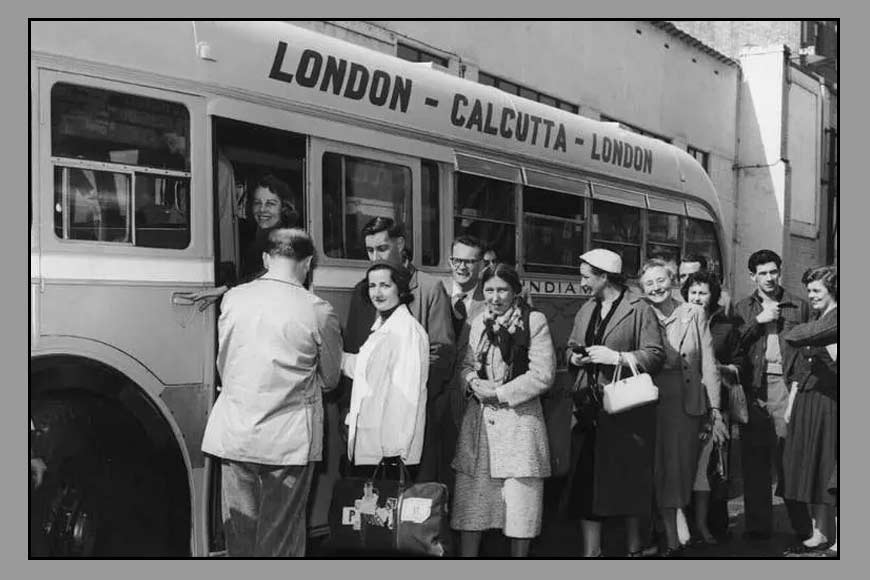The bus route between Calcutta and England that crossed 150 borders!

A bus ride from London to Calcutta in the 1950s sounds incredible, right? That was the general consensus when random news about the world’s longest luxury bus route cropped up from time to time. But recent photographs have popped up from the annals of long-forgotten history to bust the large-scale confusion and skepticism of the masses. Since last year, an image went viral on internet depicting passengers boarding the Calcutta-bound bus from Victoria Coach Station in London. And now an advertisement of the bus has also appeared in the public domain to substantiate the claim.
The double-decker bus was known as Albert and the trips covered by it were called Albert Tours service from London, England to Calcutta. It is said to be the longest bus route in the world that began its journey from London on April 15, 1957. Tickets were priced at £85 for the London to Calcutta section and £65 for the return journey. The inaugural trip started with 20 passengers on board among whom seven passengers (two women and five men) returned to London, thus completing the round trip. The bus was routed to India via Belgium, Yugoslavia and the north-western India. This route is also known as the Hippie Route. According to reports, it took about 50 days for the bus to reach Calcutta from London. The voyage was 7,997 km long and included all amenities like food, travel and accommodation. The bus service was operational till 1976.
During its journey, the bus travelled from England to Belgium, and from there to India via West Germany, Austria, Yugoslavia, Bulgaria, Turkey, Iran, Afghanistan, Pakistan and North Western India. After entering India, it eventually reached Calcutta via New Delhi, Agra, Allahabad and Banaras. A year-round timetable was created for the operation of Albert across Calcutta, London and Sydney. As per reports, the trips numbered 4, 5, 6, 7, 8 and 9, ran right to Sydney. The trips with numbers 12 to 15 ran between London and Calcutta.
The British luxury passenger liner RMS Titanic was called a ‘dream ship’ and was the ultimate in grandeur. Albert tours were likewise, profoundly opulent. An Albert Tour advertisement read: “'You Gain... Freedom of Movement Within the Bus. Independence From Hotels, Camp Sites, Inclement Weather.” While taking a journey on the Albert bus, one could enjoy luxury at its zenith. The lower deck of the bus had a reading and dining lounge and the upper deck had a forward observation lounge. Also, there was a fully equipped kitchen with all the amenities. For parties, there were arrangements of radio and taped music. Fan heaters inside the bus helped to keep the travelers warm. Apart from these, the interiors had bright curtains and carpets with individual sleeping bunks. With all these luxury arrangements, Albert was aptly like a ‘home away from home’.
While making its way from England, bus Albert passed by breathtaking tourist destinations like the Golden Horn of Istanbul, old Delhi, Taj Mahal of Agra, Benaras on the Ganges, the Caspian Sea coast, the Blue Danube, the Draconian Pass, the Rhine Valley, the Khyber Pass and Kabul Gorge. Additionally, the package included free shopping days in places like New Delhi, Kabul, Istanbul, Tehran, Vienna, Salzburg and many more.
After some years the bus met with an accident and became unusable. Later it was purchased by Andy Stewart, a British traveler. He rebuilt it to be a Double-Decker mobile home, which marked the beginning of the next journey. The double-decker bus was renamed Albert and travelled from Sydney to London via India on October 8, 1968. According to a report by ‘Central Western Daily,’ Stewart started from Martin Place, Sydney with 13 co-passengers to cover the journey of nearly 16,000 kilometres. He arrived in London after 132 days, on February 17, 1969. Albert Tours was a company based in England and Australia and it operated on London–Calcutta–London and London–Calcutta–Sydney routes.
The bus reached India through Iran and then it travelled to Singapore through Burma (nee Myanmar), Thailand and Malaysia. From Singapore, the bus was transported to Perth in Australia by ship, and from there it travelled by road to Sydney. The charge for this service from London to Calcutta was £145. The service had all the modern facilities as before.
The bus service was discontinued in 1976 due to escalating problems in Iran and the aggravation of tensions between Pakistan and India. Albert Tours had completed about 15 trips between Calcutta and England and four trips between England and Australia until 1976 before the service ended permanently. During its tenure, the bus had crossed nearly 150 borders and had earned the tag of a ‘friendly ambassador’ in all the nations it traversed.










